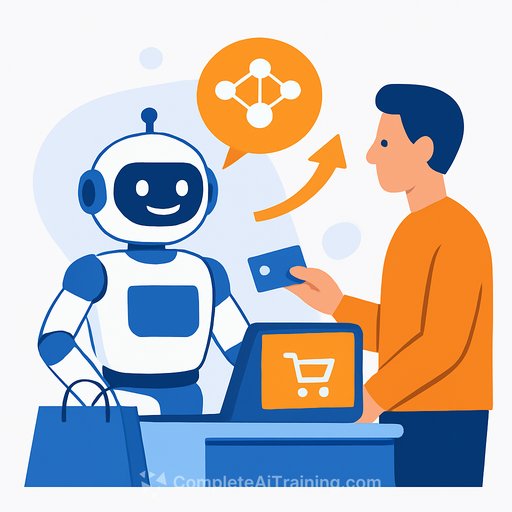Amazon's AI assistant Rufus is pacing for $10B in added sales - here's what sales leaders should copy
Amazon put a number on AI-driven conversion: its shopping assistant, Rufus, is expected to drive over $10 billion in annual incremental sales. That's not a vanity metric - it's a signal that consultative AI inside the buying flow moves revenue.
On the latest earnings call, CEO Andy Jassy said 250 million shoppers used Rufus this year. Users who engage with the assistant are 60% more likely to buy versus those who don't. Monthly active users grew 140% year over year; interactions rose 210%.
What Amazon reported
- Rufus embedded in app and web since Feb 2024; trained on catalog, reviews, Q&A, and open web. Now live across the U.S., UK, India, France, Germany, Italy, Spain, and Canada.
- New "Help Me Decide" feature guides overwhelmed shoppers through trade-offs and picks.
- Attribution: Amazon tracks "downstream impact" with a seven-day rolling window to catch delayed purchases.
- Ads inside Rufus responses contribute revenue; internal plans pegged profit impact at ~$700M this year, aiming for ~$1.2B by 2027.
- Audio summaries for product info and reviews now cover millions of items; Amazon Lens visual search hits tens of millions of monthly users.
- Company results: Q3 revenue hit $180.2B (vs. $177.8B expected). AWS grew 20% to $33B. Ads revenue rose 22% to $17.6B as the DSP added Netflix, Spotify, and SiriusXM inventory.
- Infrastructure push: 2025 capex raised to $125B; Project Rainier, an $11B AI data center, opened to run models from Anthropic, with a plan to use 1M Trainium2 chips by end of 2025.
For reference, see Amazon's investor updates and earnings materials: Amazon Investor Relations. Anthropic, the AI partner behind Claude, is here: Anthropic.
Why this matters for your funnel
- Keep buyers inside your ecosystem. Rufus reduces the need to jump to Google or other AI tools - fewer exits, more conversions.
- Make research feel like a conversation. Side-by-side comparisons, plain-language answers, and decisive recommendations shorten time-to-buy.
- Measure beyond "last click." Seven-day attribution on AI interactions captures delayed intent and true lift.
- Monetize consultative moments. Ads and cross-sells placed inside helpful answers can drive incremental margin - if you label and test them.
The 30-day playbook to test
- Week 1 - Data foundation: Aggregate product catalog, FAQs, reviews, sales call notes, and help docs. Prioritize your top 100 SKUs or most common objections.
- Week 2 - Prototype: Spin up a retrieval-augmented assistant. Seed it with "Help me decide" style comparisons and guardrails. Baseline conversion rates and bounce-to-search exits.
- Week 3 - Limited launch: Ship to 10-20% of traffic or reps. Add clear "recommended pick" and "top 3 options" patterns. Label any paid suggestions.
- Week 4 - Iterate: Tune prompts, add audio summaries for long reviews, test visual queries (upload a photo to find similar). Expand coverage to more categories.
Where to embed the assistant
- High-intent pages: pricing, product, category, checkout support.
- Inside the app: search bar, camera icon (visual search), and post-purchase upsell.
- Sales-assisted flows: rep call guides, CPQ nudges, and objection handling during demos.
- Support: turn returns and "where is my order" moments into recovery and cross-sell opportunities.
Conversion patterns worth copying
- "Best for X" recommendations: Give one primary pick, two alternates, and the trade-offs.
- "Compare A vs B vs C" modules: Side-by-side specs plus plain-English pros/cons.
- Confidence and context: "Based on 2,184 reviews and warranty terms, choose Option B if you need winter use below 20°F."
- Shortcuts: One-tap add-to-cart, save-for-later, or share-with-team.
Metrics to track (mirror Amazon's)
- Conversion rate uplift for assistant users vs. control.
- Downstream impact: revenue attributed within 7 days of an AI interaction.
- Average order value and attach rate from AI-driven recommendations.
- Search leak rate: % of sessions that leave for external search after using on-site AI.
- Coverage: % of SKUs with AI-ready summaries and comparisons.
- Response quality: helpfulness ratings and refund/return deltas.
Org and budget notes
- Ownership: Treat the assistant like a product, not a widget. One accountable lead, weekly experiments, fast approvals.
- Data and infra: Plan for ongoing spend (vector stores, inference, observability). Use a mix of vendor models and fine-tuning where it impacts margin.
- Compliance: Label ads inside answers, log citations, and add guardrails to block off-label claims.
- Rollouts: Start with one high-volume category, then scale horizontally after you see sustained lift.
Prompts customers actually use
- "Best trail running shoes for wet terrain under $150?"
- "Compare these three 27-inch monitors for photo editing."
- "Is this coat warm enough for Chicago winters?"
- "What pairs well with this camera body for low light?"
- "I need a laptop for video editing, battery-first. Top 3?"
Amazon's broader numbers support the strategy: AWS acceleration, ads momentum, and heavy AI capex including new data centers and custom chips. The company also trimmed ~14,000 corporate roles to move with fewer layers and more ownership - signaling speed and focus around AI initiatives.
Bottom line
Rufus proves that AI assistants convert when they live inside the buying moment, give clear trade-offs, and get measured on downstream revenue. Copy the patterns, keep the loop tight, and hold the assistant to the same standards as any quota-carrying channel.
Want hands-on upskilling for your sales team? Explore job-specific AI learning paths here: Complete AI Training - Courses by Job.
Your membership also unlocks:






